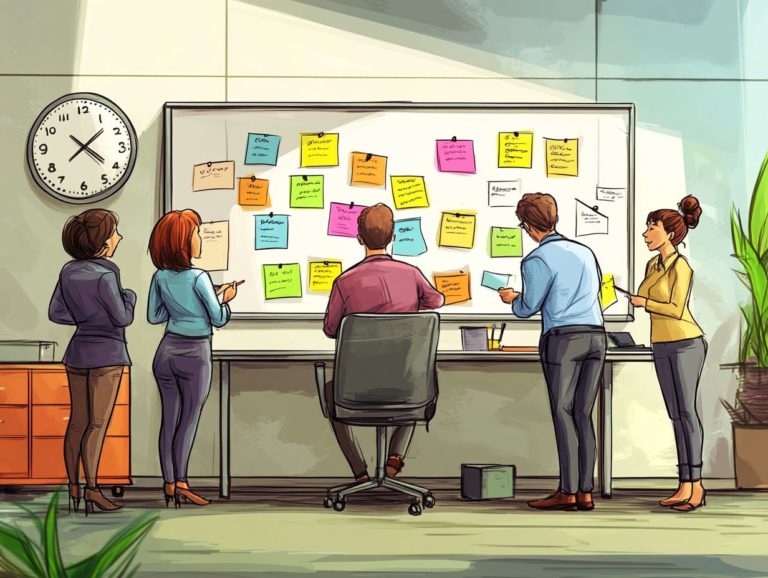Guidelines for Effective Task Prioritization
In today’s fast-paced world, mastering the art of task prioritization is absolutely essential for you. With a multitude of responsibilities competing for your attention, effectively sorting and prioritizing tasks can dramatically boost your productivity and streamline your time management.
This article delves into the essentials of task prioritization, covering its definition, benefits, common pitfalls, and practical tips to refine your approach. You’ll also discover a selection of helpful tools both digital and analog that will keep your tasks organized and manageable.
Ready to skyrocket your productivity? Let s jump in now!
Contents
- Key Takeaways:
- Understanding Task Prioritization
- Benefits of Effective Task Prioritization
- Common Mistakes in Task Prioritization
- Tips for Effective Task Prioritization
- Tools for Task Prioritization
- Frequently Asked Questions
- What are some key guidelines for effective task prioritization?
- How can setting clear goals help with task prioritization?
- Why is it important to consider both urgency and importance when prioritizing tasks?
- How can creating a to-do list help with task prioritization?
- Why is it beneficial to break down large tasks when prioritizing?
- How can communicating with others aid in task prioritization?
- Why should you regularly review and adjust task priorities?
Key Takeaways:

- Effective task prioritization is essential to increase productivity and manage time efficiently.
- Avoid common mistakes in task prioritization by identifying and implementing strategies such as the Eisenhower Matrix and ABCDE method.
- You can also use digital and analog tools, such as to-do lists and project management software, to organize and prioritize tasks effectively.
Understanding Task Prioritization
Understanding task prioritization is key to elevating productivity and ensuring effective project management within any team. It involves sorting tasks by urgency and importance, and following prioritization best practices in fast-paced environments to ensure that deadlines are met while keeping your workload manageable.
By using strategies like the Eisenhower Matrix and the ABCDE method, along with tools such as Teamwork.com and Kanban boards, you can greatly enhance your team’s task management approach.
Fostering a culture of collaboration and accountability enables organizations to allocate resources more effectively and sidestep the traps of procrastination. This ultimately boosts work performance and overall efficiency.
What is Task Prioritization?
Task prioritization is your key to mastering the art of productivity. It helps you determine the order in which tasks should be tackled based on their urgency and importance.
By assessing which tasks need your immediate attention versus those that can wait, you can elevate your productivity significantly. For instance, addressing client requests urgent and impactful should take precedence over routine email responses that can be postponed. This method not only makes your workload lighter but also gives you a great sense of achievement!
When tasks are well-organized, your time management flows seamlessly. Crucial projects receive the attention they deserve, ensuring deadlines are met without the last-minute panic. In this way, understanding prioritization becomes a powerful catalyst for achieving your personal and professional aspirations.
Benefits of Effective Task Prioritization
Effective task prioritization brings a wealth of benefits for you, including enhanced productivity, superior workload management, and the timely achievement of deadlines. To improve your skills, consider learning how to assess task value for better prioritization.
By clearly distinguishing between urgent and important tasks, you can focus your efforts on high-impact activities that drive your project goals forward. This strategic approach not only elevates your individual performance but also cultivates an environment for deep work, allowing you to concentrate on complex tasks without distractions.
Increased Productivity and Time Management

Increased productivity and effective time management stem directly from successful task prioritization. When you focus on what truly matters by sorting tasks based on urgency and importance, you re likely to experience a more structured and fulfilling day.
Consider a project manager who differentiates between daily team meetings and critical project deadlines. By doing this, they can allocate ample time to complete essential reports in advance. This thoughtful approach alleviates last-minute stress and significantly enhances the quality of their outputs.
By setting clear priorities, you can establish measurable goals that foster a sense of accomplishment. This, in turn, motivates you to pursue efficient work habits, ensuring that all deadlines are met with a calm and collected mindset.
Common Mistakes in Task Prioritization
Common mistakes in task prioritization can substantially impede your productivity and result in missed deadlines. It’s crucial for you to recognize these pitfalls and learn how to use data for effective prioritization.
Many people and teams tend to confuse urgent tasks with important ones. This confusion can lead to neglecting significant projects that demand deep work and focused attention.
Procrastination often arises when prioritization is unclear. This creates a chaotic work environment where accountability suffers.
Identifying and Avoiding Mistakes
Identifying and avoiding mistakes in task prioritization is essential for maintaining productivity and accountability within your team.
Recognizing these common errors can significantly enhance your workflow efficiency. It also fosters a collaborative environment.
It s vital for teams to regularly assess their task management systems to uncover any wasted time and efforts.
By implementing strategies like daily check-ins and utilizing priority matrices, you can ensure that everyone is aligned on goals and responsibilities.
Clear communication is pivotal in this process. It prevents misunderstandings and keeps everyone informed about shifts in priorities.
Establishing a culture of accountability enables team members to take ownership of their tasks. This ultimately leads to improved outcomes and a more cohesive unit.
Tips for Effective Task Prioritization
Implementing effective task prioritization strategies will supercharge your productivity and ensure you complete tasks on time, as highlighted in the science behind task prioritization.
Approaches like the Eisenhower Matrix, which helps you prioritize tasks by urgency and importance, and the ABCDE method enable you and your team to concentrate on what truly matters.
Cultivating a culture of accountability inspires team members to stick to their task lists and achieve their goals while keeping procrastination at bay.
Strategies for Prioritizing Tasks

Effective prioritization strategies, such as the Eisenhower Matrix and the ABCDE method, highlight the role of prioritization in time management by providing clear frameworks for categorizing tasks based on their urgency and importance.
By employing these methods, you can streamline your workflow and concentrate on what truly matters.
For instance, the Eisenhower Matrix helps you distinguish between urgent tasks and important ones, facilitating more knowledge-based decision making.
Meanwhile, the ABCDE method categorizes tasks into five distinct levels of priority. This allows you to tackle the highest-value activities first.
To elevate these strategies further, consider utilizing tools like Kanban boards. These visually track your progress and bolster accountability.
Each of these techniques not only enhances your task management but also alleviates stress by bringing clarity and organization to your daily activities.
Tools for Task Prioritization
Harnessing the right tools for task prioritization can dramatically elevate your efficiency and refine your workflow, especially when you apply key techniques for setting priorities.
Digital platforms like Teamwork.com and Asana provide robust features such as Kanban boards and automated task assignments, enabling you to visualize your workload and manage deadlines with precision.
This optimization not only fosters collaboration and accountability within your team but also enhances resource allocation and curbs procrastination. This paves the way for a more productive environment.
Digital and Analog Tools for Organizing Tasks
A range of both digital and analog tools is at your disposal to help you organize tasks effectively. Each boasts unique features tailored to different preferences.
If you lean toward modern solutions, platforms like Teamwork.com and Asana might be just what you need. These tools streamline project management and foster collaboration among team members.
On the other hand, if you find comfort in traditional methods, using checklists and planners can offer a satisfying, tactile way to visualize your tasks.
Boosting your productivity can also be achieved through techniques like the Pomodoro technique. This approach promotes focused bursts of work accompanied by brief breaks, helping you maintain concentration and stave off burnout.
By exploring various tools and strategies, you ll uncover what truly resonates with your unique working style.
Frequently Asked Questions
What are some key guidelines for effective task prioritization?

1. Set clear goals and objectives: Before prioritizing your tasks, have a clear understanding of your overall goals. This helps you determine which tasks are most important and need immediate attention, as well as how to prioritize tasks effectively.
2. Consider urgency vs. importance: When prioritizing tasks, think about what needs to be done quickly compared to what aligns with your long-term goals. This distinction helps you focus on the right activities.
3. Create a to-do list: Make a list of all your tasks in order of importance. This helps you visualize your priorities and stay organized.
4. Break down large tasks: Take charge of large tasks by breaking them down into bite-sized pieces! This keeps you focused and motivated.
5. Communicate with others: Talk to your team to understand what they need to do and coordinate tasks. This prevents duplicate efforts and ensures all important tasks are addressed.
6. Review and adjust regularly: Regularly reviewing and adjusting your task list keeps you on track. This ensures you’re working on the most important tasks at any given time.
How can setting clear goals help with task prioritization?
Setting clear goals gives you a framework for deciding which tasks are most important. By understanding your overall objectives, you can better prioritize tasks that help you reach those goals.
Why is it important to consider both urgency and importance when prioritizing tasks?
Considering urgency versus importance helps you identify what needs immediate attention and what contributes to your long-term goals. This approach prevents overwhelm from urgent tasks while ensuring important tasks aren’t neglected.
How can creating a to-do list help with task prioritization?
A to-do list provides a visual representation of your tasks and their importance. It allows you to see everything at once and easily reorder tasks based on priority.
Why is it beneficial to break down large tasks when prioritizing?
Breaking down large tasks into smaller, manageable ones makes them less overwhelming. It also allows you to see your progress, keeping you motivated as you complete each piece.
How can communicating with others aid in task prioritization?
Talking to your team helps you understand everyone’s priorities and coordinate tasks. This collaboration ensures that all essential tasks are tackled effectively.
Why should you regularly review and adjust task priorities?
Regularly reviewing and adjusting your task list ensures you’re focusing on the most important activities. This practice prevents time wastage on tasks that may no longer be relevant.
In conclusion, effective task prioritization is crucial for achieving your goals. By setting clear objectives, breaking tasks down, communicating openly, and considering key factors in task prioritization, you can enhance your productivity and ensure success.






